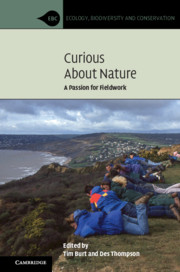Book contents
- Curious About Nature
- Ecology, Biodiversity and Conservation
- Curious About Nature
- Copyright page
- Dedication
- Contents
- Preface
- Foreword
- Part I Getting Curious About Nature
- 1 Fieldwork and Nature: Observing, Experimenting and Thinking
- 2 The Place of Field Studies in Environmental Science
- 3 The History of Fieldwork in the Geosciences
- 4 Pioneering Fieldwork Heroes in the Life Sciences
- 5 The Educational Benefits of Out-of-Classroom Learning
- Part II Essays: Inspiring Fieldwork
- Part III Reflections and Where Next for Field Studies
- Contributing Author Biographies
- Index
- References
1 - Fieldwork and Nature: Observing, Experimenting and Thinking
from Part I - Getting Curious About Nature
Published online by Cambridge University Press: 11 February 2020
- Curious About Nature
- Ecology, Biodiversity and Conservation
- Curious About Nature
- Copyright page
- Dedication
- Contents
- Preface
- Foreword
- Part I Getting Curious About Nature
- 1 Fieldwork and Nature: Observing, Experimenting and Thinking
- 2 The Place of Field Studies in Environmental Science
- 3 The History of Fieldwork in the Geosciences
- 4 Pioneering Fieldwork Heroes in the Life Sciences
- 5 The Educational Benefits of Out-of-Classroom Learning
- Part II Essays: Inspiring Fieldwork
- Part III Reflections and Where Next for Field Studies
- Contributing Author Biographies
- Index
- References
Summary
Fieldwork has the ingredients of intellectual curiosity, passion, rigour and engagement with the outdoor world – to name just a few. We may be simply noting what we see around us, making detailed records, employing sophisticated techniques, carrying out an experiment or, quite possibly, collaborating with a large international group of scientists. All of this and much more amounts to fieldwork.
- Type
- Chapter
- Information
- Curious about NatureA Passion for Fieldwork, pp. 3 - 46Publisher: Cambridge University PressPrint publication year: 2020



